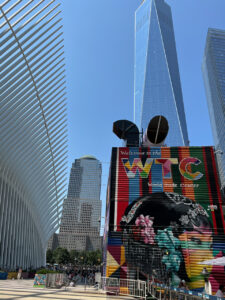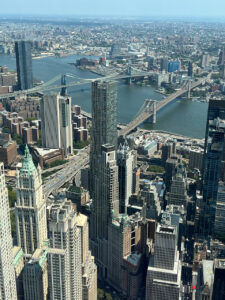
One World Trade Center at back right. (Photo by John Griswold)
Visitors this weekend who still needed to buy tickets in person to the One World Observatory, the highest place above New York City, were directed to a half-dozen digital kiosks in the building’s ground-floor lobby in Lower Manhattan.
Not all the machines were in service, and those that were insisted glitchily, repeatedly, that visitors tell them where they were from before selling them tickets. I tapped the globe on the screen several times, but the machine refused to acknowledge Illinois or Missouri as valid answers. A young employee stood behind the growing queues of agitated tourists, loudly but calmly telling them how to defeat the technology.
The information was meant to be used in the “Global Welcome Center” further on in the experience, where “your place of origin [is] added to our registry of guests…. This dazzling data is presented on the largest curved indoor LED in the world! Step in closer and you’ll become part of the show. You’ll want to share this moment with your followers!”
In other words, the slight invasion of privacy was an admission fee (in addition to $50), and guests were encouraged to share it to provide free advertising for the governmental/corporate owners of the building.
One World Trade Center, which houses the observatory, is the tallest skyscraper in the Western Hemisphere. It sits next to the footprint memorial of the missing North Twin Tower. In its planning phase after September 11, One World Trade was commonly called the Freedom Tower in response to the attacks. It was later named, more commercially but just as defiantly, for the old address of the North Tower, though it actually stands on the former site of 6 World Trade Center, also destroyed on 9-11.
One World Trade was inaugurated in 2014. With its spire it stands 1,776 feet tall, the number another reference to freedom from how things have developed in the past. The owners nod to its significance to the future by touting that it is LEED Gold-certified and an example of how to maximize population density to save resources. In a world with eight billion people, headed for 11.2 billion at the end of this century, plans for “supertall” (300-599 meters) buildings in “supercities” in “megaregions” might become reality for much of humanity.
The skyscraper is beautiful in its way—lithe, twisting, impressive—but troubling too: the vertiginous rise, its looming, the sun-glare, the mostly-locked doors. Even the incredible technological innovations that make it possible are troubling, because they are born of violence and admit the possibility of future attacks against its very reason for being—as a manifestation of power.
These innovations include a concrete “podium” base—186 feet tall, planted 70 feet into the bedrock, and set further back from the road than originally planned—to help protect against car bombs and other ground attacks. Planners feared the podium would look like a “bunker,” which would be bad for business, so a curtain of blast-resistant glass floats over it.
Everything contributing to the collapse of the Twin Towers, and the difficulties of emergency response before that happened, was analyzed and the information put into the design of One World Trade. Reinforced core columns with a minimum of two-feet thick walls provide better access and egress and help prevent collapse; the concrete has greater compression strength than anything used in the city to that point; mineral wool blanketing helps protect girders and curtainwalls against fires such as those caused by aviation fuel; stairwells can be pressurized against smoke; air intakes are designed to resist biochemical attacks; fuel lines for backup generators are shielded within the concrete; the loading dock is a quarter mile away, past a security checkpoint.
The skyscraper is an odd bunker, despite its seeming fragility. The price tag for this was new too: $3.9 billion, the most for any building to that time, part of it raised with increased toll fees and other public money. Its designs and technologies are being implemented elsewhere in the city now.

View of the East River from the observation deck. (Photo by John Griswold)
And what was the lived experience for the visitor in from the countryside to this future in the present?
There were a couple of new (to me) bits of technology, such as “SkyPod Elevators [that] climb 102 stories in 47 seconds.” Visitors were told not that they were getting on elevators, but that they had to watch a presentation, then were herded tightly into these poorly-ventilated boxes.
As we rose, the walls seemed to disappear and animated movies showed “the transformation of New York City from unsettled [sic] lands to today’s remarkable forest of skyscrapers,” at the corresponding heights of the SkyPods.
On the arrival floor a video presentation opened to the real cityscape like a curtain going up at the start of a play. Then there were pauses for corporate memorial photos, then for pad-device self-guides. At last we were free to walk around the glassed-in, climate-controlled observation deck. Other than the height of its perch, it was like many other observation decks in cities around the world. This city was magnificent, sprawling, grotesque, inspiring, hazy. Couples posed before it for their little cameras, and they were it and it was them.
